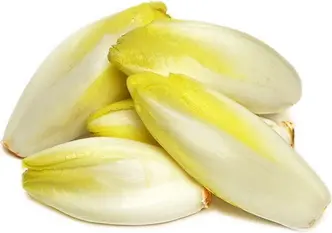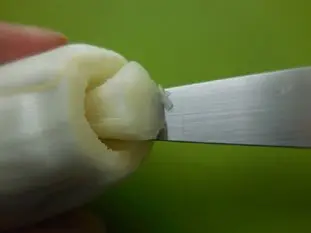The bitterness of endives

As I write these lines, we are entering the endive season, and if you like it, it's time to enjoy it, if possible with your local producers.
Endive is good, but the reproach that is often made of it, and children in particular, is: "It's bitter!
And it is (somewhat) true of course, endives have a little bitterness in them that contributes to their charm, and that we may not like. Bitterness moreover which is accentuated with cooking, it is discrete on a raw endive, a little stronger on a cooked one, and very marked on one too cooked.
So if you want to eat cooked endive that is not too bitter, is it possible?
Endive is good, but the reproach that is often made of it, and children in particular, is: "It's bitter!
And it is (somewhat) true of course, endives have a little bitterness in them that contributes to their charm, and that we may not like. Bitterness moreover which is accentuated with cooking, it is discrete on a raw endive, a little stronger on a cooked one, and very marked on one too cooked.
So if you want to eat cooked endive that is not too bitter, is it possible?
14 K 4.9/5 (16 reviews)
Keywords for this post:EndivesBitternessChildrenLast modified on: February 9th 2019
The bitterness of endives
Yes, and there is a trick to this, a trick that consists of removing, and discarding, the most bitter part of the endive, the heart, before using it.
This part, shaped like a cone, is at the base of the endive and can be removed with a small sharp knife like this:
Once this is done, use the endive as normal, but keep in mind to cook it for as little time as possible, it is not a vegetable that is meant to be cooked, but to be stopped cooking as soon as it is tender.
Another way to reduce this bitterness is to blanch them. If you have a recipe for cooked endives, for example endives au gratin, do not hesitate to blanch them for 1 or 2 minutes in boiling salted water, then drain them very carefully before using them normally.
Well, you have to be honest, you will reduce the bitterness with all this, but not make it disappear, the bitterness is part of the taste of endive, there is a big work of seduction to do with children to get them to eat it...
If you are in this moment, I suggest you to start with an endive salad with walnuts (raw then) finely sliced with a walnut oil dressing, it is a very good, and very progressive beginning, for a discovery of endive.
To sum up: For less bitter endives: 1) Remove the core 2) Cook as little as possible.
This part, shaped like a cone, is at the base of the endive and can be removed with a small sharp knife like this:

Once this is done, use the endive as normal, but keep in mind to cook it for as little time as possible, it is not a vegetable that is meant to be cooked, but to be stopped cooking as soon as it is tender.
Another way to reduce this bitterness is to blanch them. If you have a recipe for cooked endives, for example endives au gratin, do not hesitate to blanch them for 1 or 2 minutes in boiling salted water, then drain them very carefully before using them normally.
Well, you have to be honest, you will reduce the bitterness with all this, but not make it disappear, the bitterness is part of the taste of endive, there is a big work of seduction to do with children to get them to eat it...
If you are in this moment, I suggest you to start with an endive salad with walnuts (raw then) finely sliced with a walnut oil dressing, it is a very good, and very progressive beginning, for a discovery of endive.
To sum up: For less bitter endives: 1) Remove the core 2) Cook as little as possible.
Lasts posts
The importance of sieving
In recipes that use a fine powder (flour, powdered sugar, etc.), you'll often see the advice to sift before using it. To sift is to pass the powder in question through a sieve (a very fine strainer) before incorporating it into your recipe. It's often advice, but is it really useful?September 3rd 20256,5113
The grease spray
As soon as you have something in a recipe that sticks to the mold, the question always arises as to how difficult it is to remove from the mold. There's nothing more frustrating than breaking your cake when unmolding it, because part of it has stuck in the mold. The classic way to avoid this is...August 26th 20255,9185
Cake moulds
When we make a cake, or a cake of the same rectangular shape, we usually take out our usual mould and tell ourselves that the recipe is anyway "for a cake", but is it really that simple?August 25th 20256,1395
Thinning out herbs
If you need to add a long-stemmed herb (tarragon, mint, verbena, thyme, etc.) to a recipe, you'll probably only need the leaves and not the stem, so you'll need to remove the leaves. Leaf removal means keeping only the beautiful leaves, and eliminating the ugly stems and leaves, but how do you do...August 8th 20254,3215
Add a bay leaf
Bay leaf: small in size, but big in flavor. You'll find it in hundreds of recipes, and it's often added to cooking meat, in a sauce or broth, usually accompanied by other herbs or products. It's a staple of Provençal, Mediterranean and Oriental cuisine, but not the only one. Usually, in a...July 31th 20254,3465
Other pages you may also like
Steam for baking bread
What does steam have to do with bread-making? This is not only a bakers' secret, it is something you might not think of at all: if you make bread and bake it like a cake, you will end up with bread, but pale and with a thick, hard crust – a long way from the golden-brown crusty loaf you had in...June 16th 2021145 K4.5
The return of the "Norman hole"
You maybe know the "trou normand", this old gastronomic custom typically French which consists in taking a (small) glass of calvados, generally between the last course and the dessert? It's something that seems a bit anachronistic nowadays, having a glass of an alcohol of more than 60° in the...December 18th 202114 K4.8
The importance of sieving
In recipes that use a fine powder (flour, powdered sugar, etc.), you'll often see the advice to sift before using it. To sift is to pass the powder in question through a sieve (a very fine strainer) before incorporating it into your recipe. It's often advice, but is it really useful?September 3rd 20256,5113
The mock CAP baker's certificate exam
The next instalment in my life as an apprentice baker at the French INBP professional school. I’m now halfway through training and it’s still as exciting as ever, and exhausting – but maybe I’m just getting old, or both… Anyway, a few days ago we had to go through the mock CAP exam. A sort...May 1st 201821 K4.4
Unmoulding cakes while hot
When you make a cake, pound cake or whatever (what bakers call a "travel cake" because it's easy to carry around) you've most likely made a batter, either by hand or in a food processor, which you then pour into a buttered pan. It's a classic, and I've already talked to you about 2 or 3 tips on...February 6th 202138 K4.6
Post a comment or question
Follow this page
If you are interested in this page, you can "follow" it, by entering your email address here. You will then receive a notification immediately each time the page is modified or a new comment is added. Please note that you will need to confirm this following.
Note: We'll never share your e-mail address with anyone else.
Alternatively: you can subscribe to the mailing list of cooling-ez.com , you will receive a e-mail for each new recipe published on the site.








